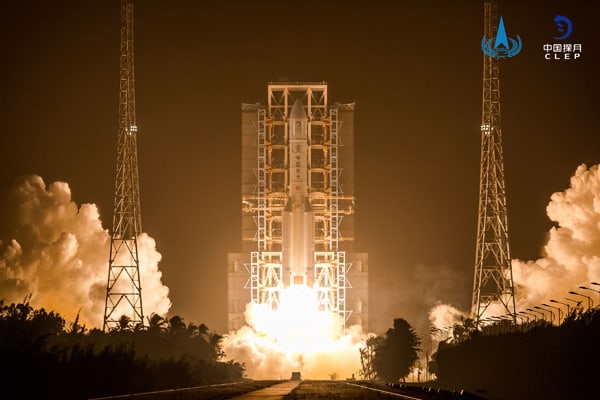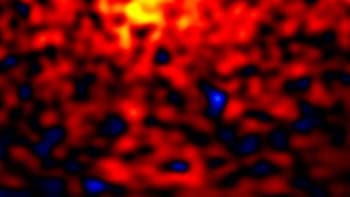
China has successfully launched a mission to bring back rocks from the Moon– the first attempt to do so for nearly 45 years. Chang’e-5 was launched at 4:30 a.m. local time today by a Long March 5 rocket from Wenchang Satellite Launch Center. Once it lands on the Moon it is expected to grab up to two kilograms of soil from an area not previously sampled to better understand the evolution history of our closest neighbour.
Chang’e-5, weighing 8.2 tonnes, consists of four parts: an ascender, lander, returner and orbiter. Upon entering the Moon’s orbit, the ascender and lander will separate and touch down in the Mons Rümker region — a volcanic mound in the northwestern part of the Moon’s near side. The lander will use a panoramic camera, spectrometer and ground-penetrating radar among other payloads to document the landing site. It will also use a robotic arm to scoop up small rocks from the surface and drill up to 2 m into the ground.
Chang’e-5 is an important step in the plan. One that deserves close attention
John Logsdon
Once the sampling is done and before the lunar night falls, the ascender will lift off from the top of the lander and dock with the returner-orbiter in orbit. The sample container is then transferred to the returner, which will head back to the Earth. Using a technology called ballistic re-entry, the returner will safely travel through the Earth’s atmosphere towards a planned landing site in Inner Mongolia, north China. It is expected that most of the returned samples will be stored at the National Astronomical Observatories of China, Chinese Academy of Science, in Beijing with possible access by foreign scientists through collaboration with Chinese colleagues.
Rock collector
Scientists believe that part of Mons Rümker might have formed 1-2 billion years ago, being much younger than the sites visited by US and Soviet sample-return missions that were over three billion years old. Back in the 1960s and 1970s, six US Apollo crewed landings brought back 382 kg of rocks from the Moon while three Soviet Luna robotic missions returned 0.326 kg. The samples from the Chinese mission will help scientists improve their model to estimate the age of surfaces in the solar system, from rocky planets such as Mars and Mercury to asteroids. Surface ages are roughly defined by crater densities: more craters, older surfaces.
If the age of Chang’e-5 samples are confirmed to be 1-2 billion years, it may challenge our current theory on the formation of the Moon, which should have cooled off by that time due to its small size and limited “heat budget”. Scientists would need to find out what had fuelled those volcanic eruptions. “[Chang’e-5] can lead to a whole new understanding of recent volcanisms on the Moon,” says Clive Neal from the University of Notre Dame in the US. “The new samples from Chang’e-5 will give us a way to quantify the younger end of the crater-counting curve.”
As China’s most complex and ambitious lunar mission so far, Chang’e-5 could go wrong in many ways. “Safe return is the most important thing for a first attempt,” adds Neal. Brett Denevi from the Applied Physics Laboratory, Johns Hopkins University, who has analyzed Apollo lunar samples, notes that China has picked “one of the best places to go” for a lunar sample-return mission. “That’s why this mission has attracted broad, international interests,” she adds, cautioning that 2 kg is an ambitious target. “Two grams can already teach us a lot,” she says. Exploring the far side
China is also working on multiple follow-up lunar missions that will eventually lead to a human mission in the 2030s. These include Chang’e-6, which will return samples from the south pole, as well as Chang’e-7 that will perform a detailed survey of the south polar region. With renewed interest in lunar exploration and the advances in sampling and analytic capabilities, space-policy expert John Logsdon from George Washington University says that Chang’e-5 could “set a new standard” for robotic lunar exploration. “Chang’e-5 is an important step in the plan,” says Logsdon. “One that deserves close attention.”



